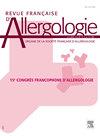Drug reaction with eosinophilia and systemic symptoms syndrome to non-steroidal anti-inflammatory drugs: A report of case series and literature review
IF 0.3
4区 医学
引用次数: 0
Abstract
Introduction
DRESS syndrome is a rare, severe cutaneous adverse reaction that has been exceptionally described with NSAIDs. The objective of our study was to investigate the clinical, paraclinical, and epidemiological characteristics of DRESS syndrome associated with NSAIDs and to identify the implicated molecules.
Patients and methods
A retrospective descriptive study that included all cases of DRESS syndrome occurring with NSAIDs and reported over a 10-year period. Records were analyzed according to the RegiSCAR criteria for the diagnosis of DRESS and the French imputability method.
Results
We included 7 cases, with a female-to-male ratio of 1.33. The age of patients ranged from 18 to 75 years, with a mean of 55 years. The time to onset varied from 4 to 30 days, with a mean of 12 days. A fever equal to or greater than 38.5 °C was observed in 5 patients. All patients had skin involvement, mainly in the form of a maculopapular rash in 6 cases and erythroderma with glossitis in one case. Hypereosinophilia was found in 4 out of 7 patients. Hepatic involvement was observed in 4 patients, associated with renal involvement in 2 cases. One patient had isolated renal involvement. The NSAIDs implicated in DRESS syndrome in our patients were diclofenac, piroxicam, ketoprofen, and celecoxib.
Conclusion
Our study highlights the rarity and potential severity of DRESS syndrome associated with NSAIDs, due to systemic involvement. Clinicians should be vigilant about the possibility of DRESS syndrome with NSAID use, in order to promptly discontinue the implicated drug and ensure rapid management.
非甾体抗炎药伴嗜酸性粒细胞增多和全身症状综合征的药物反应:病例系列报告及文献复习
dress综合征是一种罕见的、严重的皮肤不良反应,在非甾体抗炎药中有特别的描述。本研究的目的是调查与非甾体抗炎药相关的DRESS综合征的临床、临床旁和流行病学特征,并确定相关分子。患者和方法一项回顾性描述性研究,纳入了所有使用非甾体抗炎药发生的DRESS综合征病例,报告时间超过10年。根据RegiSCAR诊断DRESS的标准和法式归责法对记录进行分析。结果纳入病例7例,男女比1.33。患者年龄从18岁到75岁不等,平均55岁。发病时间从4天到30天不等,平均12天。5例患者发热大于或等于38.5℃。所有患者均有皮肤受累,主要表现为6例黄斑丘疹,1例伴有舌炎的红皮病。7例患者中有4例出现嗜酸性粒细胞增多。4例患者肝脏受累,2例合并肾脏受累。1例患者有孤立的肾脏受累。在我们的患者中,与DRESS综合征相关的非甾体抗炎药有双氯芬酸、吡罗西康、酮洛芬和塞来昔布。结论:我们的研究强调了与非甾体抗炎药相关的DRESS综合征的罕见性和潜在严重性,这是由于全身受累。临床医生应警惕使用非甾体抗炎药引起DRESS综合征的可能性,以便及时停用相关药物并确保快速管理。
本文章由计算机程序翻译,如有差异,请以英文原文为准。
求助全文
约1分钟内获得全文
求助全文
来源期刊

Revue Francaise d Allergologie
Medicine-Immunology and Allergy
自引率
33.30%
发文量
349
期刊介绍:
La Revue Française d''Allergologie : un véritable forum pour faire connaître des travaux originaux et permettre la diffusion de l''information auprès de toutes les spécialités concernées par les pathologies allergiques. La Revue Française d''Allergologie (8 numéros par an) est au carrefour de nombreuses spécialités - dermatologie, pédiatrie, ORL, pneumologie, ophtalmologie, médecine interne - qui, toutes, ont à traiter des maladies allergiques. Les symptômes des allergies fondés sur des mécanismes communs sont le plus souvent associés et se succèdent chez un même patient. En forte progression depuis 20 ans, les maladies allergiques sont dans l''attente de perfectionnements et d''avancées thérapeutiques qui permettront aux nombreux patients qui en sont atteints de mieux vivre avec leurs allergies. La Revue Française d''Allergologie se veut donc un véritable forum de discussions et d''échanges entre tous les spécialistes confrontés aux pathologies
 求助内容:
求助内容: 应助结果提醒方式:
应助结果提醒方式:


